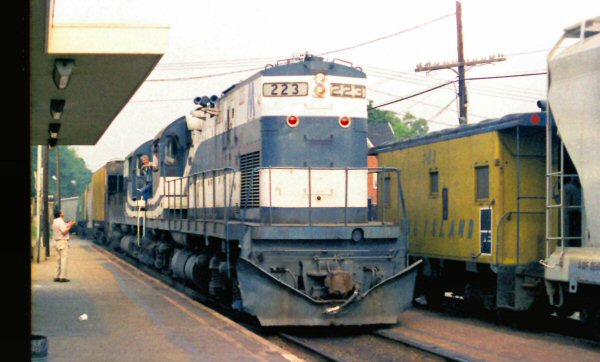
A LIRR freight job at
Courtesy of the “trainsarefun” website
The
LIRR Freight Operations, Pre-1997 by
John Kilbride
LIST
Semaphore Feb. 2017
When
Most recently, documents maintained by the
now-closed LIRR freight department were made available for review, which
prompted a glimpse of days past and memories of the fleets of F-M or ALCo
locomotives.
Freight and Yard Service Crew Assignments
Five sets of road crew schedules were included
with issue dates from 1971 to 1986. Beginning my review in 1971 because it had
the largest number of trains, I plotted those assignments (22) by initial
terminals (5) and frequencies. Some of the interesting findings were assignments
that worked one routing on Mon, Wed and Friday and a different one on Tues. and
Thurs. Daylight starts out-numbered nights (19/3). All LIRR branches were
covered at least weekly, including the Port Washington, Hempstead and
The 1974 set listed assignments as “RF”
(Road Freight) for the first time. Holban Yard was the major Terminal, a
distinction that lasted until the 1985 set. Also by then the west end Terminals
had been replaced by ones further out on the island (Pinelawn, Pine-aire and
Customer Carload Reports (1974-1988)
Also provided was a three part “Customer
Carload Report”, a document that included (in Part I) “public delivery track
locations” (30) and car capacity (various, but totaling 389 in 1977.)
Part II of the report included an alphabetical
list of “customers having private or assigned sidings.” The eight pages
contain over 420 customers; in some cases some with locations in multiple
places!! By the 1993 report, these locations were grouped geographically and the
Part III report – car loads handled – was combined with the Part II section,
effectively putting all data together on the same sheet for easier review.
Included was the previous four years information so that trends could be viewed.
An interesting feature: the commodity been moved was listed included (ie:
lumber, feed, flour, pulp board, etc., a total of 18 categories) Railroad
analysts could now see and comply their reports on a varied sort of available
data, including freight traffic by individual branches. (I conclude that only
loaded cars were counted (since there are several odd numbers shown!) and the
data can be adjusted if empties are to be included for the “big picture”. My
next challenge: reviewing the information from 1974-88 (three 5-year sets of
information to plot any pattern(s) of traffic changes. Immediately obvious - -
the declining numbers for many customers! Unknown – where might the statistics
of empty cars placed to handle outbound products, especially if a different
commodity than an inbound with raw material(s), be listed?
LIRR gossip among rail historians offers a
thought that the LIRR freight salesman were actively and proudly sell-ing their
services but that MTA officials did not want to be involved in freight
operations. I've included a photo of a 1955 freight sign hanging on the side of
A staggering statistic – the LIRR was
handling only 15% of the island's freight business at the end! NY&A figures
reveal they handled 9,200 carloads in the beginning (and over 28,000 in 2013.)
…...and the caboose fleet
Finally, I can't end without mentioning the
fleet of caboose's used and maintained by the LIRR. Beginning with the wooden
four-wheeled versions in use at the time of the PRR ownership, steel-framed
(N-52) cupola- equipped versions appeared in 1916 (3) that would expand to over
30 into the 1950's. (3 remain as static displays on
It was a glorious tradition to go trackside
and either count cars or make note of the varied logos of
(Author's note: For an excellent news
article on the LIRR's freight train operations, seek out “The
Other LIRR”, Newsday, 2/11/79)

A LIRR freight job at
Courtesy of the “trainsarefun”
website